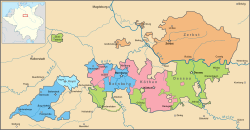Anhalt-Köthen
| Principality (Duchy) of Anhalt-Köthen | ||||||||||
| Fürstentum (Herzogtum) Anhalt-Köthen | ||||||||||
|
State of the Holy Roman Empire (until 1806) Member of the Confederation of the Rhine (1807–13) Member of the German Confederation (from 1815) |
||||||||||
|
||||||||||
|
||||||||||
|
Anhalt principalities, 1747-1793: Anhalt-Köthen in pink
|
||||||||||
| Capital | Köthen | |||||||||
| Government | Principality | |||||||||
| Historical era | Middle Ages | |||||||||
| • | Partitioned from Anhalt-Zerbst | 1396 | ||||||||
| • | Inherited by Anhalt-Dessau | 1562 | ||||||||
| • | Partitioned from Anhalt-Zerbst | 1603 | ||||||||
| • | Partitioned to create Anhalt-Pless | 1774 | ||||||||
| • | Raised to duchy | 1806 | ||||||||
| • | Merged with Anhalt-Dessau | 1847 1863 | ||||||||
| • | Duchy of Anhalt reunited | 1863 | ||||||||
|
||||||||||
| Today part of |
|
|||||||||
Anhalt-Köthen was a principality of the Holy Roman Empire ruled by the House of Ascania. It was created in 1396 when the Principality of Anhalt-Zerbst was partitioned between Anhalt-Dessau and Anhalt-Köthen. The first creation lasted until 1562 when it fell to Prince Joachim Ernest of Anhalt-Zerbst, who merged it into the reunited Principality of Anhalt.
It was created for a second time in 1603 when Anhalt was again divided. In 1806 Anhalt-Köthen was raised to a duchy. With the death of Duke Henry on 23 November 1847 the Anhalt-Köthen line became extinct and its territories were united to Anhalt-Dessau by patent of 22 May 1853.
The Principality of Anhalt arose in 1212 under its first ruler Henry I, son of the Saxon duke Bernhard III. Named after Anhalt Castle, the ancestral seat of the Ascanian dynasty near Harzgerode, the principality experienced a number of partitions throughout its centuries-long existence. When Henry died in 1252, his sons divided their heritage, with the younger, Prince Siegfried I receiving the Anhalt-Zerbst territory including Dessau and Köthen.
The Principality of Anhalt-Köthen emerged in 1396, when the two surviving sons of late Prince John II of Anhalt-Zerbst divided their heritage and the younger, Prince Albert IV, took his residence at Köthen. Upon the death of his elder brother Prince Sigismund I of Anhalt-Dessau in 1405, Albert also acted as a regent for Sigismund's minor sons. He himself died in 1423 and was succeeded by his sons Adolph I and Waldemar V. Waldemar died in 1436 and Adolph entered a long-time quarrel with their cousin Prince George I of Anhalt-Dessau, finally in 1471, both concluded a succession contract whereby George took over the government of half the principality and became co-ruler as Lord of Köthen.
...
Wikipedia



